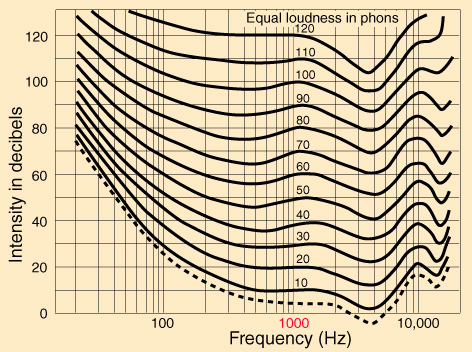Introduction to eSSB Audio
|
| NU9N SSB / eSSB Hi-fi Audio Introduction The psychological magnitude loudness is associated with a given SPL. Judgments of whether two sine tones sound equally loud show fairly low dispersion among different individuals.
Judgments on "how much" louder one tone is than another require previous conditioning or training and yield results that fluctuate greatly from individual to individual and from occasion to occasion.
Curves of Equal Loudness and the "Fetcher Munsen Curve" Tones of the same SPL but with different frequencies are in general judged as having different loudness. SPL is thus not a good measure of loudness, if we inter compare tones of different
frequency. Experiments have been performed to establish curves of equal loudness, taking the SPL at 1 KHz as a reference quantity. These are shown below...
This shows the relationship between volume and frequency response of your ears, or what does the "Loudness" button do. For example, at 20 Hz, the lowest SPL you can hear is about 65 dB. At 500 Hz however you can hear all the way down to 0 dB. Notice that around 3kHz is the most sensitive region. A Phon is a unit of volume that roughly corresponds with dB SPL. The chart below demonstrates the threshold of hearing at different decibel levels across the frequency range of human hearing. As decibel level increases, the frequency response of our ears begins to flatten. This is known as the Fletcher-Munson curve.
The characteristic we identify with the shout is the power behind it, the force used to make the sound travel. When we measure something in decibels, we take the ratio of the power of the measured
sound (P) to the reference-level power (Pr) of 10-12 watts per square meter. The actual decibel reading is mathematically expressed 10 log10 (P/Pr). You can add and subtract decibels, but you can multiply or divide them. Since not all
frequencies are perceived to be as loud to the human ear, even at equal power, most decibel meters attenuate to the specific frequencies while making a measurement. Twenty decibels is not twice as loud as 10 dB, but 10 times as loud.
To double the perceived loudness of a violin, you need an additional 8-9 violinists. That's one reason why a modern symphony orchestra has as many members as it does, to achieve a balanced volume.
The graph below represents a sloping plot of about -3dB/Octave: This graph would be produced by what I consider to be ideal "sounding" audio in this bandwidth, while still being relatively narrow compared with that of an Amplitude Modulated (AM) signal. Notice
the gradual downward slope as frequency increases. This is normal and is theoretically the characteristic of perceived flatness such as "Pink Noise". Again, if the graph had been a straight line all at the same amplitude, the perceived
"sound" of it would be very brittle and tinny such as "White Noise".
This next graph displays a comparison of 5 different types of transmission; These lines look a bit confusing, but as you can see, there are some major differences in these graphs and in the sounds of each audio source that produced them.
Pink Noise is perfectly and perceptibly "Flat" (linear as opposed to logarithmic) descending 3dB/Oct., and spans from 20Hz ~ 20kHz. AM Broadcast (White) has about a 9.5kHz audio bandwidth (that's a 19kHz RF bandwidth) and is relatively flat from about 60Hz ~ 9.5kHz with roll-off occurring below and above this. The Red line was yours truly on my Kenwood TS-850S / DSP-100 with some processing. The Cyan graph was made while listening to a 3.5kHz (N2) SSB station. And the Yellow graph was made while listening to one of the prominent DX'ers on the 20 meter band which is more common for SSB than not. With a few fundamentals being presented, this site was designed to help you achieve a sound that would produce a graph similar to GRAPH 1 for both transmit and receive. If I can be of any assistance in any way with your setup, send an e-Mail to: John@nu9n.com Please see "SSB RX Setup" and "SSB TX Setup" for more details and explanations. |
|
There are many philosophies among the Amateur community regarding SSB audio and mine basically boils down to two... "Rag-Chew Audio" and "DX Audio". This site is exclusively dedicated for the "Rag-Chew"
type of audio! My personal SSB audio manifesto is this:
|
|
All information given on this site are the express opinions of NU9N and I assume no responsibility
for the outcome produced by such suggestions and opinions that may cause band splatter, distortion and/or unacceptable transmitter I. M.
D. products.
There are those who will profoundly disagree with the contents and philosophy of this site, regarding the purposes of what the amateur radio service was intended to accomplish. However, it is my contention and desire to enhance the experimental aspect of the hobby while keeping with FCC rules and regulations and being a service (nonprofit of course) to those interested in producing exceptional narrow-band and extended-band high quality SSB audio. Every amateur radio operator is responsible for his or her signal quality and compliance with FCC standards, as vague as they may be in some respect. Copyright Notice: All contents of this site, including text, graphics and MP3 audio recordings, are considered the property of NU9N and are protected by copyright law and may not be reproduced or distributed in any way or form, without the express written consent of NU9N. |
| John M. Anning - NU9N
e-Mail: |
Apologetics 1 | Apologetics 2 | Audio Glossary | Donate | eSSB Mods | eSSB Ready Rigs | Transmitter Settings for eSSB
File Downloads | News | Radio Connections | Transmitter Settings | Scope Your Audio | Site Map | Site Search | T-Pad Calculator




